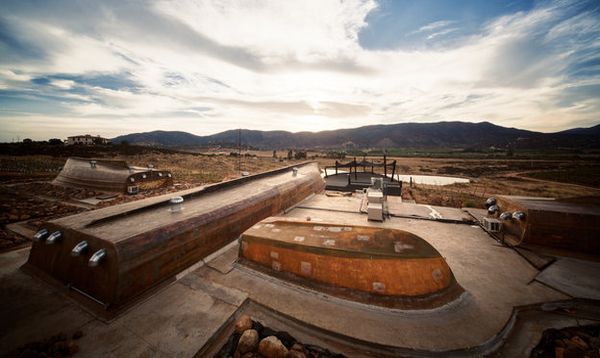Baja California, Mexico - A lot of artists say they find inspiration in unlikely places. Architects Alejandro D'Acosta and Claudia Turrent, designers based in Ensenada, Mexico, most often find theirs digging through dumpsters and junkyards.
Their work, however, isn't remotely trashy. One of their latest creations, the Vena Cava Winery in Baja's Guadalupe Valley, is sleek and totally modern. It's one of a growing number of wineries that's designed to give visitors a memorable visual experience — not just a taste of fine wine.
The vaulted ceilings of Vena Cava are made out of salvaged discarded boats from a nearby port. Some of the walls are decorated with discarded lenses from a local eyeglass factory. In addition to these distinctive emblems of place, the winery incorporates the shapes and colors of the region's natural landscape so that it almost blends in.
With their passion for reclaimed materials, the husband and wife team have secured a niche designing stunning, upscale wineries and other buildings in Baja. They've designed five wineries to date, and have two more in the works.
The Mexican wine industry has been flourishing lately, prompting The Economist to call the Guadalupe Valley the "Napa of Mexico." D'Acosta says he and Turrent are in the right place to experiment with winery design, at the right time.
Designing a winery is a lot like designing a factory, D'Acosta says. The structures have to accommodate a lot of specialized equipment to process the grapes and filter the wine. Even small details like the distance between the distilling equipment and the storage barrels can affect how the wine tastes.
 |
D'Acosta and Turrent say boats make durable ceilings because they are designed to be weatherproof and water-resistant. |
They're committed to minimizing their impact on the Earth, and they have recycling down to a science and an art. They collect materials from everywhere — local factories, junkyards, and demolition sites. And then they brainstorm and test them out.
"You have to think about an object's original use," said D'Acosta. "What are its strengths? And how might an architect use those strengths to his advantage?"
Old glass bottles, for example, are great for insulation, D'Acosta says. A corked glass bottle isn't too different from a double-paned window — air trapped inside glass reduces the amount of heat that's transferred from one side to the other.
Tires are very strong, and versatile, they've discovered. For the remodeled Bodegas de Santo Thomas, Mexico's oldest winery, D'Acosta and Turrent used 22,000 tires to build the retention walls.
And since boats are designed to be weatherproof and water-resistant, they make for very durable ceilings.
But it's not just about functionality. "When you recycle a boat, or when you reuse an object, part of the original soul of the object is still there," D'Acosta says.
A lot of trash and scrap from the US tends to end up in Mexico, D'Acosta says. He figures he might as well put it to good use.
"I have seven brothers and my father has 10 brothers, which meant we ended up with a lot of hand-me-downs. I don't think I never had new clothes — maybe once!" he laughs. "The idea of reusing things became very natural," D'Acosta said.
"And it's not about being rich or poor," he says. "It's about getting the most out of what you already have."
Original Story


